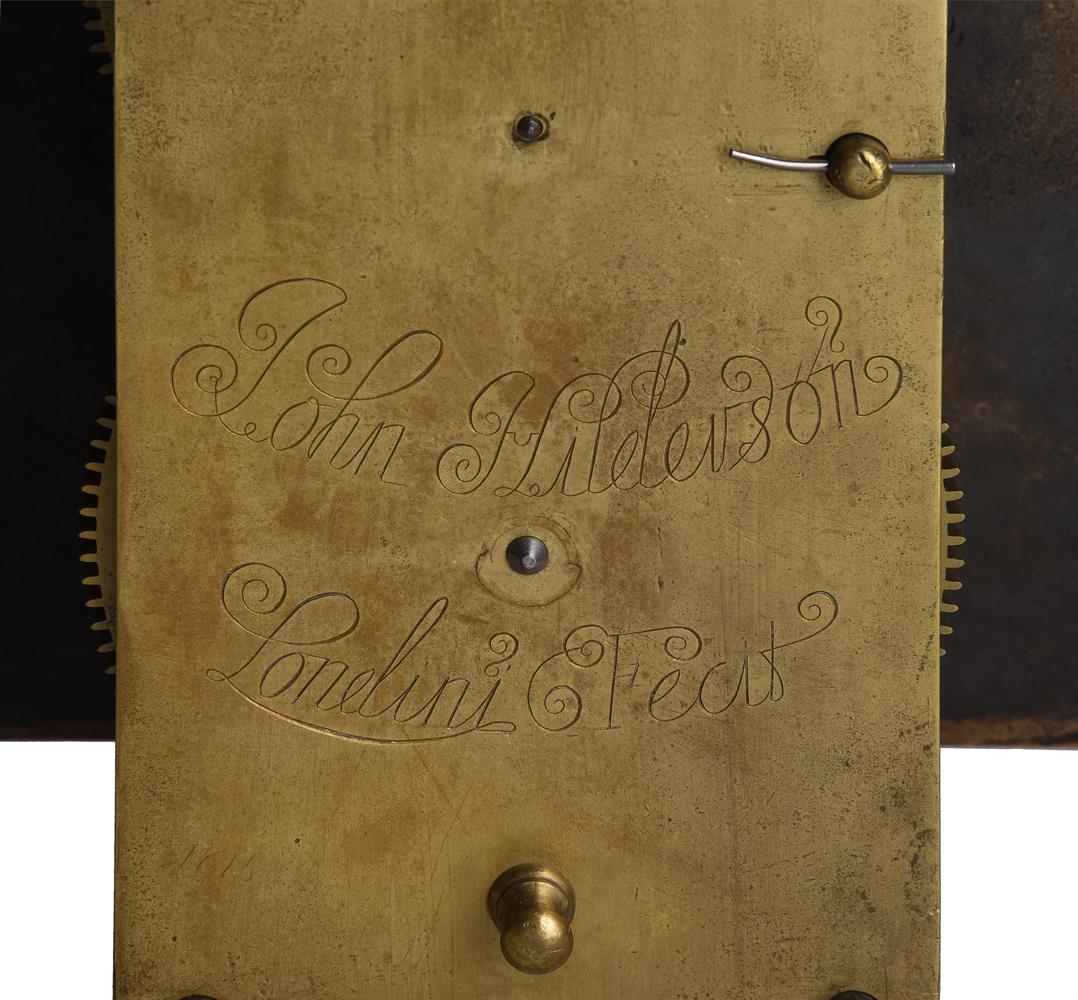AN ARCHITECTURAL EBONY EIGHT-DAY VERGE HOODED WALL TIMEPIECE JOHN HILDERSON, LONDON, CIRCA 1660-65 AND LATER The single train key-wound movement with verge escapement regulated by short-bob pendulum with knife-edge suspension, the plates measuring 8.75 by 3.5 inches united by four generous baluster-turned pillars pinned to the rear and boldly signed in flamboyant scrolling script John Hilderson, Londini Fecit over pendulum holdfast hook to the backplate, with an 8.75 inch square gilt brass dial with six-petal rose engraved decoration to the finely matted centre within applied narrow silvered Roman numeral chapter ring with stylised simple fleur-de-lys half hour markers and Arabic five minutes within the outer minute track, with fine sculpted steel hands and conforming matting to spandrel areas within a narrow burnished border to the edge of the plate, now secured via an angled catch into a re-constructed ebony veneered architectural hooded wall case of indeterminate age with fine complex mouldings to the triangular pediment over raised mouldings to the fixed glazed dial aperture and conforming rectangular side windows to the rising hood, the bracket with ogee-shaped mouldings to the table over simple cavetto-fronted side brackets, the backboard fitted with iron hanging eye to top and short spurs to base. 47.5cm (18.75ins) high, 31.5cm (12.375ins) wide, 16.5cm (6.5ins) deep. John Hilderson is recorded in Loomes, Brian Clockmakers of Britain 1286-1700 as most likely an immigrant (possibly Dutch) due to the many different spellings of his name. Loomes notes that an individual with this name first appears as an Ensign in the Royalist Army in 1642 then again as a captain in Lord St. John's Regiment of Foot under the Earl of Essex in the Parliamentary Army, but comments that this military man may be him or someone quite unrelated. In 1652 a 'John Hendrickson' was given leave to work as a journeyman for the clockmaker John Champion. Hilderson was apparently never officially admitted into the Clockmaker's Company but was allowed to take apprentices namely Samuel Hayley in 1657 and Thomas Watson in 1662. In July 1656 John Hilderson married Susan Watson; he was last mentioned in the Company archives in 1662 and died in 1665 possibly of the plague. John Hilderson worked from Chesell Street and is believed to have had strong connections with Edward East due to the unmistakable similarities in their work. He was clearly a highly regarded maker as he was asked to repair/remake one of the two Bruse-Oosterwijck pendulum sea clocks that had been badly damaged due to a storm during passage across the British Channel in 1662. The movement of the current lot is a fine survivor retaining its original verge pendulum escapement made no later than seven years after its invention and introduction to London by the Fromanteel Family. In addition to this the movement is beautifully signed in flowing script typical of Hilderson and exhibits a high degree of finish exemplified by the confidently executed movement pillars.
AN ARCHITECTURAL EBONY EIGHT-DAY VERGE HOODED WALL TIMEPIECE JOHN HILDERSON, LONDON, CIRCA 1660-65 AND LATER The single train key-wound movement with verge escapement regulated by short-bob pendulum with knife-edge suspension, the plates measuring 8.75 by 3.5 inches united by four generous baluster-turned pillars pinned to the rear and boldly signed in flamboyant scrolling script John Hilderson, Londini Fecit over pendulum holdfast hook to the backplate, with an 8.75 inch square gilt brass dial with six-petal rose engraved decoration to the finely matted centre within applied narrow silvered Roman numeral chapter ring with stylised simple fleur-de-lys half hour markers and Arabic five minutes within the outer minute track, with fine sculpted steel hands and conforming matting to spandrel areas within a narrow burnished border to the edge of the plate, now secured via an angled catch into a re-constructed ebony veneered architectural hooded wall case of indeterminate age with fine complex mouldings to the triangular pediment over raised mouldings to the fixed glazed dial aperture and conforming rectangular side windows to the rising hood, the bracket with ogee-shaped mouldings to the table over simple cavetto-fronted side brackets, the backboard fitted with iron hanging eye to top and short spurs to base. 47.5cm (18.75ins) high, 31.5cm (12.375ins) wide, 16.5cm (6.5ins) deep. John Hilderson is recorded in Loomes, Brian Clockmakers of Britain 1286-1700 as most likely an immigrant (possibly Dutch) due to the many different spellings of his name. Loomes notes that an individual with this name first appears as an Ensign in the Royalist Army in 1642 then again as a captain in Lord St. John's Regiment of Foot under the Earl of Essex in the Parliamentary Army, but comments that this military man may be him or someone quite unrelated. In 1652 a 'John Hendrickson' was given leave to work as a journeyman for the clockmaker John Champion. Hilderson was apparently never officially admitted into the Clockmaker's Company but was allowed to take apprentices namely Samuel Hayley in 1657 and Thomas Watson in 1662. In July 1656 John Hilderson married Susan Watson; he was last mentioned in the Company archives in 1662 and died in 1665 possibly of the plague. John Hilderson worked from Chesell Street and is believed to have had strong connections with Edward East due to the unmistakable similarities in their work. He was clearly a highly regarded maker as he was asked to repair/remake one of the two Bruse-Oosterwijck pendulum sea clocks that had been badly damaged due to a storm during passage across the British Channel in 1662. The movement of the current lot is a fine survivor retaining its original verge pendulum escapement made no later than seven years after its invention and introduction to London by the Fromanteel Family. In addition to this the movement is beautifully signed in flowing script typical of Hilderson and exhibits a high degree of finish exemplified by the confidently executed movement pillars.




.jpg)








.jpg)
.jpg)
Try LotSearch and its premium features for 7 days - without any costs!
Be notified automatically about new items in upcoming auctions.
Create an alert